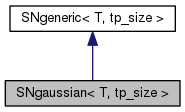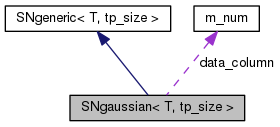|
finitediff
|
|
finitediff
|
#include <SNgaussian.h>


Public Member Functions | |
| SNgaussian () | |
| template<class U , unsigned int s> | |
| SNgaussian (const SNgeneric< U, s > &A, const m_num &c=0) | |
| SNgaussian< T, tp_size > | inverse () const |
| void | setColumn (const m_num &col) |
| m_num | getColumn () const |
 Public Member Functions inherited from SNgeneric< T, tp_size > Public Member Functions inherited from SNgeneric< T, tp_size > | |
| virtual unsigned int | getSize () const final |
| virtual T & | at (const m_num, const m_num) final |
| virtual T | get (const m_num, const m_num) const final |
| virtual SNline< T, tp_size > | getSNline (m_num l) const |
| template<class V , unsigned int s> | |
| void | subtract (const SNgeneric< V, s > &) |
| template<class V , unsigned int s> | |
| void | subtract (const SNgaussian< V, s > &) |
| SNgaussian< T, tp_size > | getGaussian (const m_num c) const |
| template<class V , unsigned int s> | |
| bool | isNumericallyEqual (const SNgeneric< V, s > &A, const double &epsilon) const |
Private Member Functions | |
| SpecialValue< T > | checkForSpecialElements (const m_num &i, const m_num &j) const |
| template<class U , unsigned int s> | |
| void | populate_from (const SNgeneric< U, s > &) |
| SNgaussian (const std::array< T, tp_size > &d, const m_num &c) | |
| T | _get (m_num, m_num) const override |
| T & | _at (m_num, m_num) override |
Private Attributes | |
| std::array< T, tp_size > | data |
| m_num | data_column |
This represents a gaussian matrix.
A gaussian matrix is the multiplicative matrix which serves to eliminate a column under the diagonal.
Let  be a matrix and
be a matrix and  be an index. Let
be an index. Let  . The gaussian matrix for
. The gaussian matrix for  on the index
on the index  is full of zeros except for
is full of zeros except for
 on the diagonal
on the diagonal on position
on position  when
when  .
.That is there is something non trivial only on the column  , under the diagonal.
, under the diagonal.
TODO : giving 'c' as a template argument, one can in average spare half of the memory by allowing 'c' as size in 'data' instead of 'tp_size'.
|
private |
Construct a matrix from its data. See the implementation of '_at'
| SNgaussian< T, tp_size >::SNgaussian | ( | ) |
The non-parameter constructor initializes the member data_column to tp_size+1 (which is impossible). This is checked by the function _at so that you cannot populate the matrix before to initialize.
use setColumn()
| SNgaussian< T, tp_size >::SNgaussian | ( | const SNgeneric< U, s > & | A, |
| const m_num & | c = 0 |
||
| ) |
Construct a gaussian matrix from a generic one by
Default column is zero. So
will produce the gaussian matrix of E for its first column (first=number zero) provided the type and size of E are compatible with "double" and zero.
|
overrideprivatevirtual |
The elements are stored in std::array<T,tp_size> data while the matrix only contains non fixed values on one column, under the diagonal.
First element of data stores the first non fixed value. Example for a gaussian matrix on column 1 :

Only the first (tp_size-c-1) elements of 'data' are used.
Implements SNgeneric< T, tp_size >.
|
overrideprivatevirtual |
Return by value the requested element of the matrix
Implements SNgeneric< T, tp_size >.
|
private |
checkForSpecialElements(i,j) checks for element (i,j). If this is a special element (a one whose value is fixed by the fact that we are a gaussian matrix) then it returns a 'SpecialValue<T>' with its boolean part set to true, meaning that this is a special value. In that case :
If this is not a special value, it returns a 'SpecialValue<T>' with boolean part set to false. In that case :
| m_num SNgaussian< T, tp_size >::getColumn | ( | ) | const |
| SNgaussian< T, tp_size > SNgaussian< T, tp_size >::inverse | ( | ) | const |
|
private |
| void SNgaussian< T, tp_size >::setColumn | ( | const m_num & | col | ) |
Set the number of the line on which one has non trivial elements.
|
private |
|
private |
 1.8.11
1.8.11